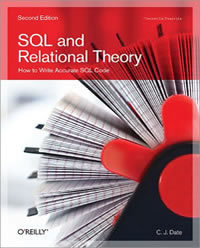SEARCH
Disclaimer: Authors have full rights over their works. Reproduction of any part of the content is prohibited without prior authorization.
BOOK SQL AND RELATIONAL THEORY HOW TO WRITE ACCURATE SQL CODE, 2ND EDITION
SUMMARY
-
Items Found: 173
- Preface to the First Edition xi
- Chapter 1 Setting the Scene 1
- The relational model is much misunderstood 1
- Some remarks on terminology 2
- Principles not products 4
- A review of the original model 5
- Model vs. implementation 12
- Properties of relations 14
- Base vs. derived relations 18
- Relations vs. relvars 19
- Values vs. variables 21
- Concluding remarks 22
- Exercises 23
- Chapter 2 Types and Domains 25
- Types and relations 25
- Equality comparisons 26
- Data value atomicity 31
- What’s a type? 34
- Scalar vs. nonscalar types 37
- Scalar types in SQL 39
- Type checking and coercion in SQL 40
- Collations in SQL 42
- Row and table types in SQL 43
- Concluding remarks 45
- Exercises 46
- Chapter 3 Tuples and Relations, Rows and Tables 49
- What’s a tuple? 49
- Rows in SQL 53
- What’s a relation? 55
- Relations and their bodies 57
- Relations are n-dimensional 58
- Relational comparisons 58
- TABLE_DUM and TABLE_DEE 59
- Tables in SQL 60
- Column naming in SQL 62
- Concluding remarks 64
- Exercises 64
- Chapter 4 No Duplicates, No Nulls 67
- What’s wrong with duplicates? 67
- Duplicates: further issues 72
- Avoiding duplicates in SQL 72
- What’s wrong with nulls? 74
- Avoiding nulls in SQL 77
- A remark on outer join 79
- Concluding remarks 80
- Exercises 80
- Chapter 5 Base Relvars, Base Tables 85
- Updating is set level 86
- Relational assignment 88
- More on candidate keys 92
- More on foreign keys 94
- Relvars and predicates 97
- Relations vs. types 99
- Exercises 101
- Chapter 6 SQL and Relational Algebra I: The Original Operators 105
- Some preliminaries 105
- More on closure 108
- Restriction 110
- Projection 111
- Join 112
- Union, intersection, and difference 116
- Which operators are primitive? 119
- Formulating expressions one step at a time 119
- What do relational expressions mean? 121
- Evaluating SQL table expressions 122
- Expression transformation 123
- The reliance on attribute names 125
- Exercises 127
- Chapter 7 SQL and Relational Algebra II: Additional Operators 131
- Exclusive union 131
- Semijoin and semidifference 132
- Extend 133
- Image relations 135
- Divide 138
- Aggregate operators 139
- Image relations bis 144
- Summarization 146
- Summarization bis 150
- Group, ungroup, and relation valued attributes 152
- “What if” queries 157
- A note on recursion 159
- What about ORDER BY? 163
- Exercises 164
- Chapter 8 SQL and Constraints 169
- Type constraints 169
- Type constraints in SQL 173
- Database constraints 174
- Database constraints in SQL 178
- Transactions 180
- Why database constraint checking must be immediate 180
- But doesn’t some checking have to be deferred? 182
- Constraints and predicates 185
- Miscellaneous issues 186
- Exercises 188
- Chapter 9 SQL and Views 193
- Views are relvars 194
- Views and predicates 197
- Retrieval operations 198
- Views and constraints 199
- Update operations 203
- What are views for? 211
- Views and snapshots 212
- Exercises 213
- Chapter 10 SQL and Logic 215
- Why do we need logic? 216
- Simple and compound propositions 217
- Simple and compound predicates 222
- Quantification 223
- Relational calculus 227
- More on quantification 234
- Some equivalences 241
- Concluding remarks 244
- Exercises 244
- Chapter 11 Using Logic to Formulate SQL Expressions 247
- Some transformation laws 247
- Example 1: Logical implication 250
- Example 2: Universal quantification 251
- Example 3: Implication and universal quantification 252
- Example 4: Correlated subqueries 254
- Example 5: Naming subexpressions 255
- Example 6: More on naming subexpressions 258
- Example 7: Dealing with ambiguity 259
- Example 8: Using COUNT 261
- Example 9: Join queries 262
- Example 10: UNIQUE quantification 263
- Example 11: ALL or ANY comparisons 265
- Example 12: GROUP BY and HAVING 269
- Exercises 270
- Chapter 12 Miscellaneous SQL Topics 273
- SELECT * 273
- Explicit tables 274
- Name qualification 274
- Range variables 275
- Subqueries 277
- “Possibly nondeterministic” expressions 280
- Empty sets 281
- A simplified BNF grammar 281
- Exercises 285
- Appendix A The Relational Model 287
- The relational model vs. others 288
- The significance of theory 291
- The relational model defined 293
- Database variables 298
- Objectives of the relational model 299
- Some database principles 300
- What remains to be done? 301
- Appendix B SQL Departures from the Relational Model 305
- Appendix C A Relational Approach to Missing Information 307
- Vertical decomposition 308
- Horizontal decomposition 309
- What do the shaded entries mean? 311
- Constraints 313
- Queries 314
- More on predicates 317
- Exercises 320
- Appendix D A Tutorial D Grammar 321
- Appendix E Summary of Recommendations 325
- Appendix F Answers to Exercises 329
- Chapter 1 329
- Chapter 2 335
- Chapter 3 341
- Chapter 4 346
- Chapter 5 352
- Chapter 6 358
- Chapter 7 366
- Chapter 8 379
- Chapter 9 389
- Chapter 10 395
- Chapter 11 403
- Chapter 12 405
- Appendix C 407
- Appendix G Suggestions for Further Reading 409
- Index 419


